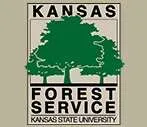Kansas Forest Service grant used to reduce sedimentation of federal reservoirs to improve water quality
MANHATTAN, Kan. – A Kansas Forest Service official says streamside forests and woodlands have improved during the course of a six-year, $1.8 million project, but work remains to ensure the viability of local water resources.
Robert Atchison, coordinator of the rural forestry program at KFS, said the agency has administered the grant from the Regional Conservation Partnership Program (RCPP) to focus on water quality conservation forestry practices on more than 14,296 acres in Kansas.
“The project focused on water quality and quantity resource concerns associated with the loss of riparian forests and streambank erosion, which contributes to the sedimentation and nutrient loading of federal reservoirs,” Atchison said.
RCPP is a grant program of the Natural Resources Conservation Service that coordinates activities to address on-farm, watershed and regional natural resource concerns.
Atchison said federal reservoirs in Kansas are losing water storage capacity to sedimentation – some have lost more than 40%. Nutrient loading from runoff into streams and rivers that feed the reservoirs are causing frequent algal blooms that can be harmful to humans and animals.
These reservoirs provide water in some manner for two-thirds of the state’s population.
“Healthy, functioning riparian forests are an integral piece in improving the quantity and quality of water in Kansas reservoirs,” Atchison said. “Our foresters worked with landowners to conduct more than 5,000 acres of forest stand improvement during the grant, ensuring the long-term function of the forests.”
The forests intercept rainfall in their canopy, reducing the amount of rain that reaches the ground. When rainfall reaches the ground, the trees take up water from the soil through their roots, increasing soil water storage and reducing runoff.
Atchison said forests’ contribution of organic matter also increases water storage in the soil. Forested watersheds produce less runoff, reducing downstream flooding that can erode streambanks, damage property and destroy habitat.
The 125 acres of riparian forest buffers that were planted will provide long-term bank stabilization benefits as well as increase wildlife and aquatic habitat.
Atchison said additional grants provided $2.3 million in technical assistance that were used to hire additional foresters to serve Kansans. The RCPP grant also generated more than $12 million in contributions by partner agencies.
The Kansas Forest Service used $273,000 in grant funds to help focus outreach and conduct Stream Visual Assessment Protocol (SVAP). The Kansas Alliance of Wetland Streams (KAWS) led the work to conduct a forest inventory, riparian forest assessments and GIS classification of functioning stream condition in 10 priority watersheds. This information will guide future work, according to Atchison.
He added the project brought significant attention to the important role riparian forests play in stabilizing streambanks and reducing sediment loads. However, the grant had it challenges, and barriers still need to be overcome to restore and protect riparian forests.
“While we’ve made great progress with our many partners, we still face challenges with the high cost of bank stabilization, inadequate financial incentives to engage landowners, and the hesitation to give up cropland for riparian forest buffers,” Atchison said. “All of this needs to be addressed for the work to continue, along with state funding support for water quality forester positions.”
FOR PRINT PUBLICATIONS: Links used in this story
Kansas Forest Service, www.kansasforests.org
About the Kansas Forest Service
The Kansas Forest Service is the nation’s fifth oldest state forestry agency. The agency serves rural landowners, communities, rural fire districts, forest and arboriculture industries, and citizens of the state through its Conservation Tree and Shrub Planting, Fire Management, Community Forestry, Rural Forestry, Marketing and Utilization, and Forest Health programs. The Kansas Forest Service state office is located in Manhattan, Kansas, just west of the campus of Kansas State University. The Kansas Forest Service is housed as an independent agency within K-State Research and Extension. The agency receives its direction from a mission statement that reads: “Care of natural resources and service to people through forestry.”
About K-State Research and Extension
K State Research and Extension is a short name for the Kansas State University Agricultural Experiment Station and Cooperative Extension Service, a program designed to generate and distribute useful knowledge for the well being of Kansans. Supported by county, state, federal and private funds, the program has county extension offices, experiment fields, area extension offices and regional research centers statewide. Its headquarters is on the K State campus in Manhattan. For more information, visit www.ksre.ksu.edu. K-State Research and Extension is an equal opportunity provider and employer.
For more information:
Robert Atchison
785-532-3310
[email protected]





